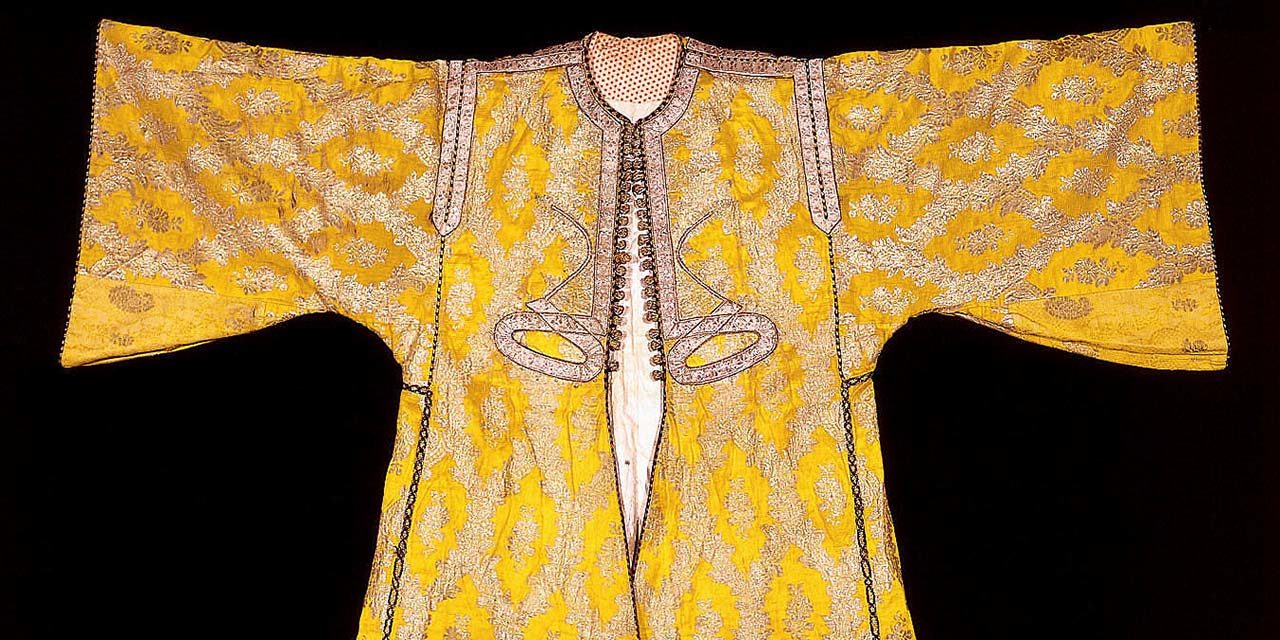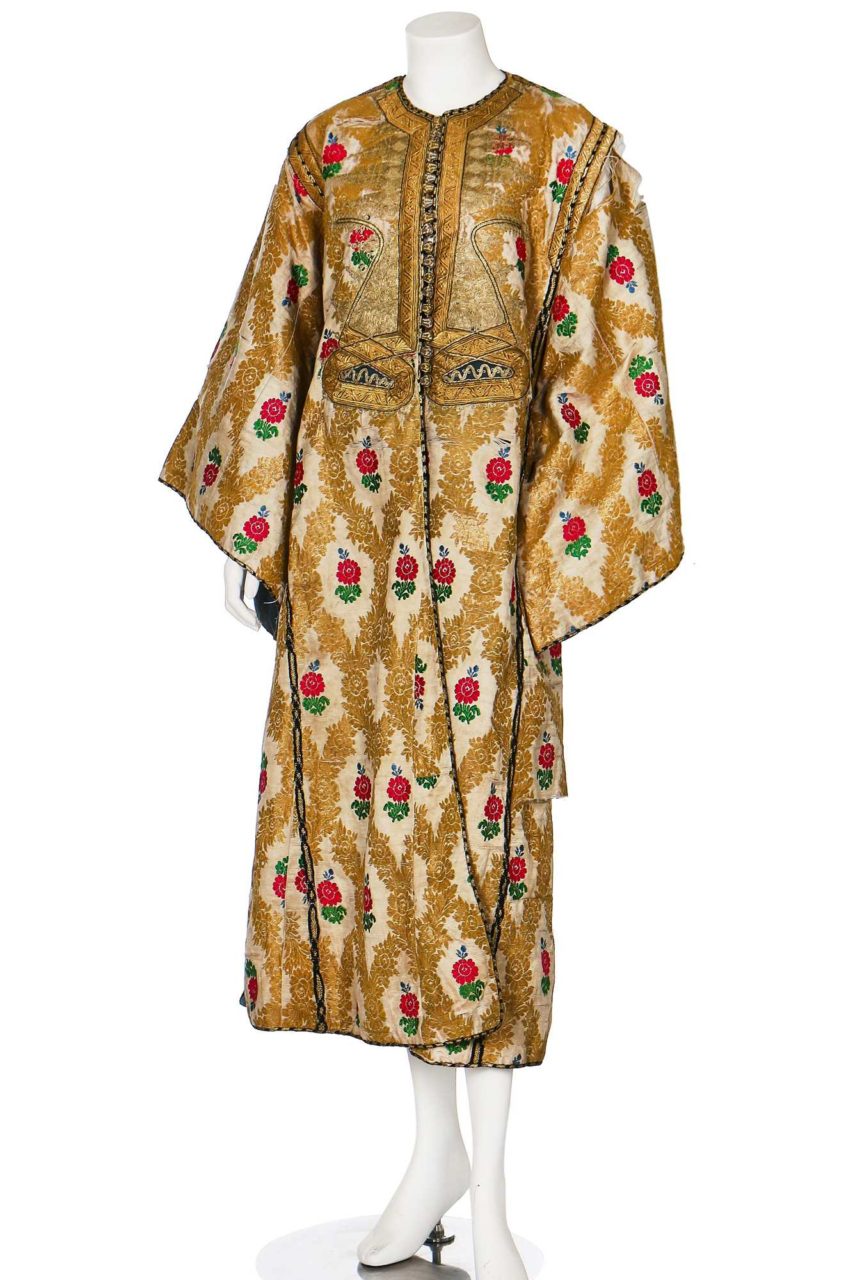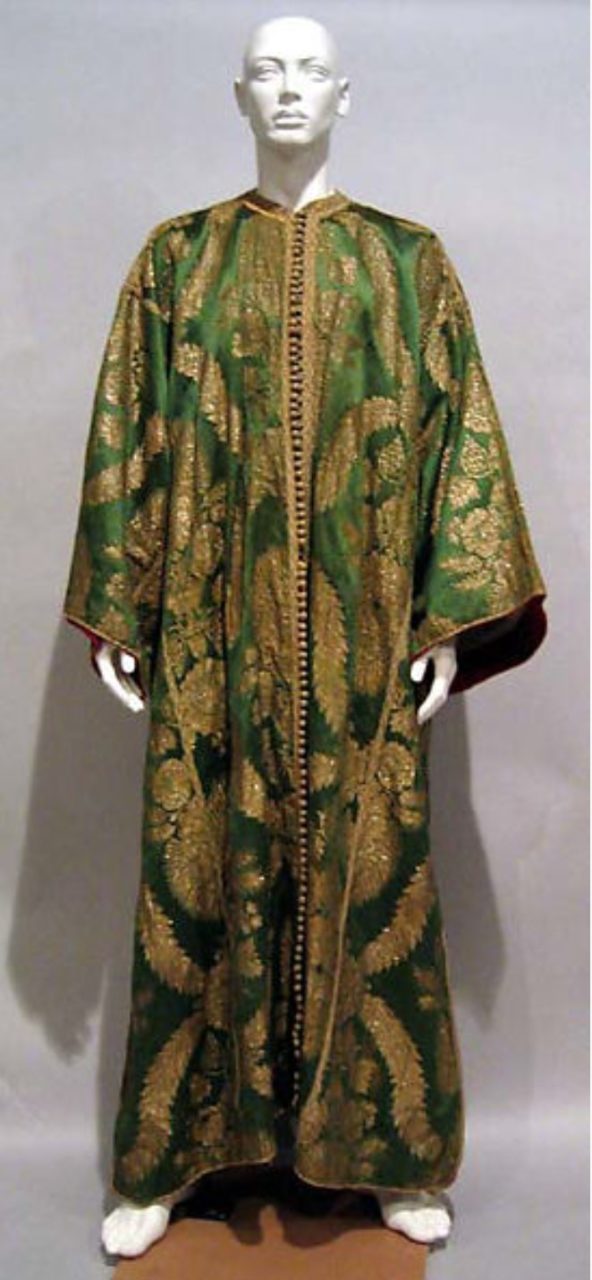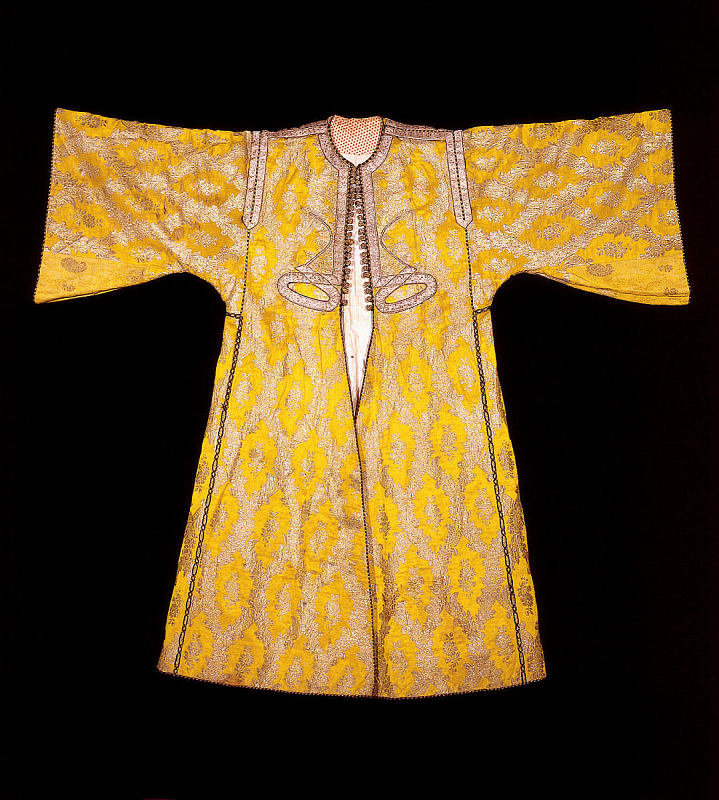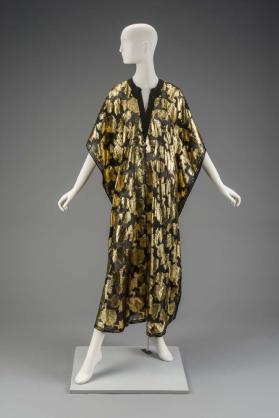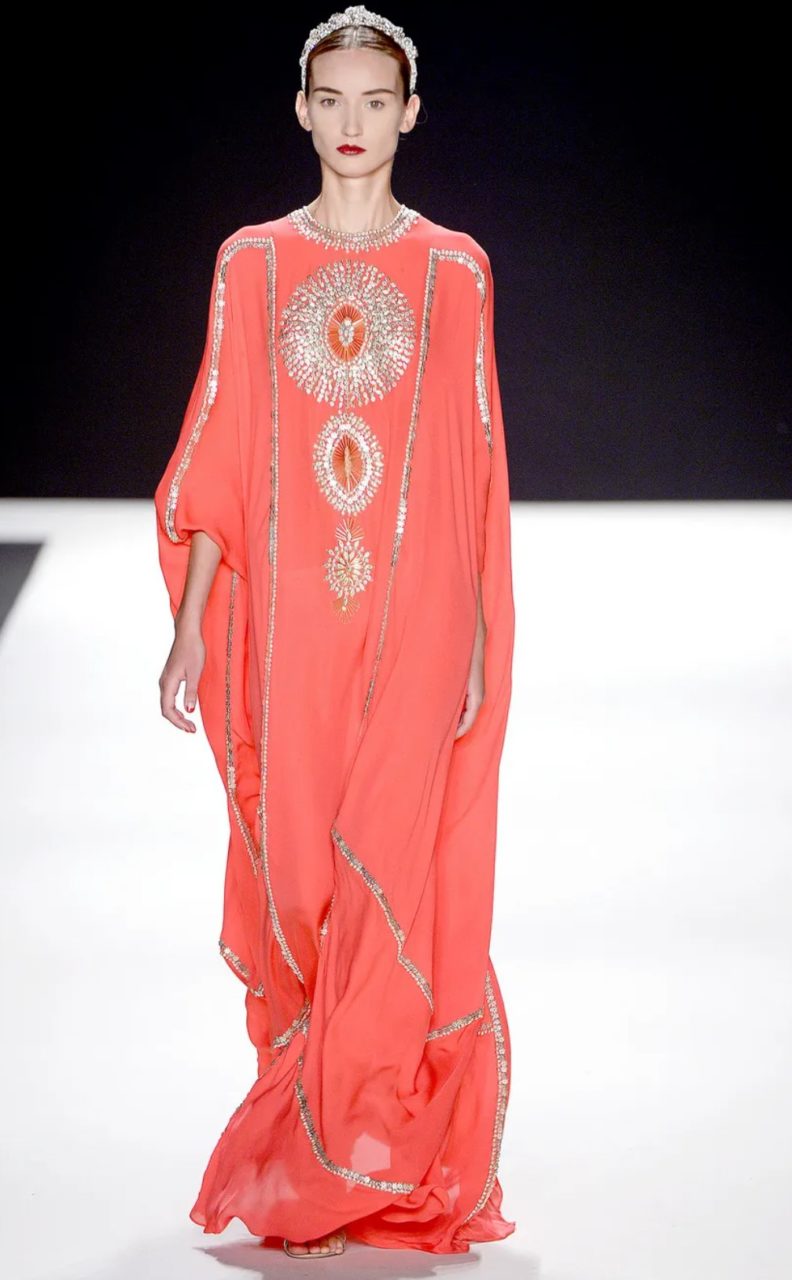The kaftan (also caftan) is an ancient garment, which originated in ancient Persia but then spread across Central and Western Asia. It is a kind of robe or tunic that was worn by both men and women. Kaftans are still worn today in different ways.
The Details
Daniel Delis Hill describes the kaftan and its construction in The History of World Costume and Fashion (2011):
“In Arabia at the dawn of the Islamic empire, the most common masculine garment was the long, loose-fitting tunic called a kaftan (also caftan). In its simplest form, the Arabian tunic was probably T-cut in the same manner as the Roman tunica and Egyptian kalasiris. Kaftans were often worn girded by a wide sash that was sometimes long enough to wrap about the waist several times.” (166)
An early 20th-century silk kaftan (Fig. 1) from Morocco has a floral brocade pattern with a button closure and integrated belt. The green and gold kaftan seen in figure 2 has long, loose sleeves and features buttons from the collar down to the hem of the garment.
The Smithsonian National Museum of African Art describes a 19th-century yellow silk kaftan (Fig. 3) from their collection:
“This style of clothing probably originated in Persia and eventually spread and became popular throughout the Arab world. Caftans were worn by both men and women, especially scholars and high-ranking officials who were part of the Moroccan urban elite. This particular type of caftan was probably worn as part of a bridal costume and was likely an early style garment due to the wide sleeves. Later caftan styles have narrower sleeves, much like European clothing. This older style caftan is rarely worn today.”
Charlotte Jirousek describes the kaftan and the word’s origins in “The Kaftan and Its Origins” in Berg Encyclopedia of World Dress and Fashion: Central and Southwest Asia (2010):
“The term kaftan (also spelled caftan) usually refers to a long, unfitted coat of Turkic, Persian, or Central Asian origin. It can also refer to the outermost layer of a series of coats and jackets, worn by either men or women. The word kaftan came into the English language in the late sixteenth century, when it was introduced as the Turkish term used to describe the long, formal coats worn by members of the Ottoman court. The word is also found in various forms in Turkish, Persian, Russian, and East European languages, as well as many Central Asian languages.” (134)
The Metropolitan Museum of Art, which has many kaftans in its collection (Fig. 2), writes of the garment’s origins:
“The type of garment referred to as kaftan was known in Persia and the Ottoman Empire before arriving in Morocco, probably in the 16th century. Kaftans made of elegant materials such as silk brocade or velvet were reserved for special occasions.” (502)
The MFA Boston has a 1980s blue velvet, high waistline kaftan (Fig. 4) with machine stitching in gold, green, red, and blue in their collection.
The Encyclopedia of National Dress: Traditional Clothing Around the World (2013) explains how women in the Islamic period used to wear kaftans:
“Most urban women wore a caftan in the house, which is a collarless robe with wide sleeves. Caftans were introduced in the early Islamic period from Iran to Andalus and then, with Andalusian refugees to Morocco. Caftans could be made of rich silk brocade or something fairly plain and simple.”
A 1980s women’s black and gold kaftan (Fig. 5) from Saudi Arabia is sheer, with a gold applique pattern and a black trim border around the neckline, and down the center front to create a v-shape.
Wikipedia gives a broad context for the kaftan:
“A kaftan or caftan is a variant of the robe or tunic; originating in Asia, it has been worn by a number of cultures around the world for thousands of years. In Russian usage, kaftan instead refers to a style of men’s long suit with tight sleeves. Though the kaftan is of ancient Mesopotamian (modern-day Iraq) origin, it has been used by many West and Southwest Asian ethnic groups. It may be made of wool, cashmere, silk, or cotton, and may be worn with a sash. Popular during the time of the Ottoman Empire, detailed and elaborately designed garments were given to ambassadors and other important guests at the Topkapi Palace. Variations of the kaftan were inherited by cultures throughout Asia and were worn by individuals in Russia, Southwest Asia, and Northern Africa Styles, uses, and names for the kaftan vary from culture to culture. The kaftan is often worn as a coat or as an overdress, usually having long sleeves and reaching to the ankles. In regions with a warm climate, it is worn as a lightweight, loose-fitting garment. In some cultures, the kaftan has served as a symbol of royalty.”
Fig. 1 - Maker unknown (Moroccan). Brocaded silk kaftan, early 20th century. Silk brocade, metal thread, silk satin. London: Kerry Taylor. Source: Kerry Taylor Auctions
Fig. 2 - Artist unknown (Moroccan). Caftan, early 20th century. Silk and metal wrapped thread; brocaded. New York: The Metropolitan Museum of Art, 1970.84.6. Bequest of Clarissa Gwendoline Condon, 1968. Source: The Met
Fig. 3 - Artist unknown (Moroccan). Caftan, Mid-19th century. Silk, cotton, metal-wrapped thread; h x w: 135.7 x 152.8 cm (53 7/16 x 60 3/16 inches). Washington: National Museum of African Art - Smithsonian Institution, 2001-19-1. Gift of the Aherne family, in memory of Brian and Eleanor Aherne. Source: NMAA
Fig. 4 - Artist unknown (Bedouin, Saudi Arabia). Kaftan, 1980-1985. Velvet; machine-embroidered; 132.1 cm (52 inches). Boston: Museum of Fine Arts, 2014.447. Gift of Dawn Nordblom in memory of Rodger P. Nordblom. Source: MFA Boston
Fig. 5 - Artist unknown (Saudi Arabia). Kaftan, 1980-1985. Synthetic black plain weave, sup. cont., lurex-gold metallic wefts; clipped. Boston: Museum Of Fine Arts, 2014.442. Gift of Dawn Nordblom in memory of Rodger P. Nordblom. Source: MFA Boston
Its Afterlife
In more recent times, the kaftan still has a place in everyday life as well as in the collections of many designers. For example, in his Spring/Summer 2013 collection, Naeem Kahn introduced his ready-to-wear collection with a variety of kaftan-inspired dresses (Figs. 6 & 7). Pakistani-born Khan created kaftans with vivid colors, metallic embellishment details and wide sleeves. Another example is in the Oscar de la Renta Spring/Summer 2020 collection, designed by Fernando Garcia and Laura Kim, which showed a long, kaftan-inspired gown made of pleated metallic gold fabric (Fig. 8).
Fig. 6 - Naeem Khan. Yellow kaftan, Spring 2013. Photo by Alessandro Viero. Source: Vogue
Fig. 7 - Naeem Kahn. Kaftan, Spring 2013. Photo by Alessandro Viero. Source: Vogue
Fig. 8 - Fernando Garcia and Laura Kim. Oscar de la Renta, Spring 2020. Photo by Filippo Fior. Source: Vogue
References:
- “Caftan – Works – National Museum of African Art – Smithsonian Institution.” https://africa.si.edu/collections/objects/14176/caftan?ctx=f3ac526d8bd863069fcfc4ce99e8aad41e48c328&idx=0
- Condra, Jill. Encyclopedia of National Dress: Traditional Clothing Around the World. Santa Barbara: ABC-CLIO, 2013. https://search-ebscohost-com.libproxy.fitsuny.edu/login.aspx?direct=true&db=nlebk&AN=658629&site=ehost-live
- “Farajiya/Farasia kaftan.” Metropolitan Museum of Art. Accessed March 19, 2022. https://www.metmuseum.org/art/collection/search/85626
- Hill, Daniel Delis. History of World Costume and Fashion. Upper Saddle River: Pearson Prentice Hall, 2011. http://www.worldcat.org/oclc/768100950
- Jirousek, Charlotte. “The Kaftan and Its Origins.” In Berg Encyclopedia of World Dress and Fashion: Central and Southwest Asia, edited by Gillian Vogelsang-Eastwood, 134–138. Oxford: Berg Publishers, 2010. http://dx.doi.org.libproxy.fitsuny.edu/10.2752/BEWDF/EDch5023.
-
“Kaftan.” In Wikipedia, March 9, 2022. https://en.wikipedia.org/w/index.php?title=Kaftan&oldid=1076194098.

